《A MANUAL OF INTERNATIONAL LAW》
| 作者 | GEORG SCHWARZENBERGER AND E.D. 编者 |
|---|---|
| 出版 | PROFESSIONAL BOOKS LIMITED |
| 参考页数 | 612 |
| 出版时间 | 1976(求助前请核对) 目录预览 |
| ISBN号 | 无 — 求助条款 |
| PDF编号 | 818860378(仅供预览,未存储实际文件) |
| 求助格式 | 扫描PDF(若分多册发行,每次仅能受理1册) |
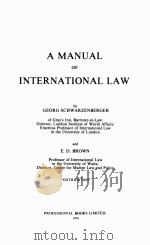
PART ONE.: ELEMENTS OF INTERNATIONAL LAW3
1.INTERNATIONAL LAW IN PERSPECTIVE3
Ⅰ. Distinctions3
Ⅱ. The Perspectives of International Law4
A. International Law in Historical Perspective5
B. International Law in Sociological Perspective7
C. International Law in Ethical Perspective13
Ⅲ. The Doctrine of International Law14
A. The Place of the Doctrine of International Law14
B. Histoty of the Doctrine of International Law15
2.THE FOUNDATIONS OF INTERNATIONAL LAW21
Ⅰ. The Law-Creating Processes21
A. Treaties24
B. International Customary Law26
C. The General Principles of Law27
Ⅱ. The Law-Determing Agencies28
A. Principal and Subsidiary Law-Determining Agencies28
B. Elements of Law-Determining Agencies29
Ⅲ. The System of Intern ational Law32
Ⅳ. The Fundamental Principles of International Law33
A. The Rules of International Law35
B. The Principles of International Law35
C. The Fundamental Principles of International Law35
D. Optional Principles and Standards36
V. International Law and Municipal Law36
A. Conflicting Doctrines37
B. The Struggle for Supremacy37
C. The Exclusiveness of International Law39
D. The Formative Influence of Municipal Law on International Law40
E. The Application of Municipal Law by International Organs40
F. The Blending of International Law and Municipal Law41
3.INTERNATIONAL PERSONALITY42
Ⅰ. International Personality in Historical Perspective43
Ⅱ. Typical Subjects of Intern ational Law43
A. Independent States43
B. Dependent States48
C. League Mandates and United Nations Trust Territories49
Ⅲ. The Principle of Sovereignty51
A. The Meaning of Sovereignty51
B. The Governing Rules52
C. The Co-existence of Sovereign States52
D. The Complementary Character of the Rules of International Law53
E. The Significance of Negative Sovereignty54
Ⅳ. The Principle of Recognition54
A. The Functions of Recognition55
B. Underlying Rules55
V. The Acquisition of International Personality56
A. Modes of Acquisition of International Personality56
B. Recognition of States58
C. Recognition of Governments and Heads of State59
D. Recognition of Insurgency and Belligerency61
Ⅵ. Non-Typical Subjects of International Law62
A. The Holy See62
B. International Institutions63
C. Individuals64
Ⅶ. International Representation65
A. Heads of State65
B. Ministers65
C. Diplomatic Representatives66
D. Representation of, in and at International Institutions66
E. Consuls68
Ⅷ Continuity and Discontinuity of International Personality68
A. The Relativity of Continuity and Discontinuity of International Personality68
B. The Legal Consequences of the Cession of Territory69
C. Subrogation and Treaties70
D. The Alleged Rule of General State Succession70
4.STATE JURISDICTIONⅠ. The Statics and Dynamics of the Problem72
Ⅱ. The Forms of State Jurisdiction73
A. Personal and Territorial Jurisdiction74
B. Ordinary and Extraordinary Jurisdiction75
C. Unlimited and Limited Jurisdiction76
D. Potential and Actual Jurisdiction77
Ⅲ. Limitations of State Jurisdiction under International Customary Law78
A. The Evolution of the Governing Rules78
B. Diplomatic and Consular Immunities79
4. STATE JURISDICTION—contd.81
Ⅲ. Limitations of State Jurisdiction—contd.81
C. State Immunity81
D. Innocent Passage and Ships in Distress83
E. Minimum Standards in Favour of Foreigners84
F. The Abuse of Rights84
Ⅳ. Limitations of Jurisdiction by Way of Treaty85
A. The Law of International Institutions86
B. International Economic Law87
C. International Social Law90
D. International Criminal Law91
E. International Air and Space Law92
5. OBJECTS OF INTERNATIONAL LAW95
Ⅰ. Territory96
A. Titles to Territory96
B. National Air Space100
C. Internal Waters, the Territorial Sea and Contiguous Zone100
D. The Continental Shelf and the Sea-bed beyond National Jurisdiction106
Ⅱ. The High Seas108
A. The Principle of the Freedom of the Sea108
B. Exceptions110
Ⅲ. Individuals and Companies112
A. Individuals112
B. Companies115
Ⅳ. Ships and Aircraft116
6. INTERNATIONAL TRANSACTIONS118
Ⅰ. The Principle of Good Faith118
Ⅱ. The Principle of Consent119
Ⅲ. Treaties121
A. The Meaning and Functions of Treaties121
B. The Compatibility of Treaties with the Principles of Sovereignty and Equality of States123
C. Public Contracts123
D. The Conclusion of Treaties123
E. Legal Effects of Treaties129
F. The Interpretation of Treaties133
G. The Revision of Treaties136
H. The Suspension and Termination of Treaties137
Ⅳ. Unilateral Acts140
A. Types of Unilateral Acts140
B. Legal Characteristics and Effects of Unilateral Acts141
C. Parallel and Collective Acts141
V. The Principle of International Responsibility141
A. The Breach of an International Obligation142
B. The Legal Interest of the Claimant143
C. Identity of the Tortfeasor145
D. The Requirement of Fault146
E. Reparation147
7.THE LAW OF ARMED CONFLICT148
Ⅰ. The Principle of Self-Defence149
Ⅱ. Measures of Self-Help150
Ⅲ. The Three States of International Law151
Ⅳ. Collective Security152
Ⅴ. State and Effects of War155
A. State of War155
B. Effects of War156
Ⅵ. Functions and Foundations of the Laws of War159
A. Functions of the Laws of War159
B. Foundations of the Laws of War162
Ⅶ. The Law of Land Warfare163
A. Limitations ratione loci163
B. Limitations ratione instrumenti163
C. Limitations ratione personae164
Ⅷ. The Law of Sea Warfare166
Ⅸ. The Law of Air Warfare169
X. Breaches of the Rules of Warfare170
Ⅺ. Armed Conflicts not of an International Character172
A. Colonial Wars172
B. Civil Wars172
C. Co-Belligerency173
D. The Impact of the Geneva Red Cross Conventions of 1949173
Ⅻ, Termination of War174
8.THE LAW OF NEUTRALITY176
Ⅰ. Neutrality in Historical Perspective176
Ⅱ. The Basic Rules177
Ⅲ. Permanent Neutrality and Neutralisation178
Ⅳ. Rights and Duties of Neutral States179
A. Neutrality in Land Warfare179
B. Neutrality in Sea Warfare181
C. Neutrality in Air Warfare183
V. Neutral Nationals and Property in War on Land183
A. Presence in a Belligerent's Own Territory183
B. Presence in Occupied Territory184
C. Presence in Enemy Territory184
Ⅵ. Neutral Nationals and Property in War at Sea184
A. The Right of Visit and Search185
B. Seizure, Destruction and Adjudication of Neutral Prize186
C. Con?raband187
D. The Doctrine of Continuous Voyage188
E. Unneutral Services188
F. Submarine Cables and Wireless Telegraphy189
G. The Rule of the War of 1756189
H. Blockade190
I. Defence Areas, War Zones and Mines190
J. Scope and Limits of Maritime Reprisals191
9THE LAW OF INTERNATIONAL INSTITUTIONS:Ⅰ. NON-COMPREHENSIVE INSTITUTIONS192
Ⅰ. Types of Intern ational Institutions192
Ⅱ. Judicial Intern ational Institutions194
A. Patterns for the Peaceful Settlement of International Disputes194
B. Arbitration in Historical Perspective195
C. Functions197
D. Organisation198
E. Jurisdiction200
F. Procedure204
G. Judgments and Advisory Opinions205
H. An Evanescent Mystique208
Ⅲ. Governmental International Institutions209
Ⅳ. Administrative International Institutions210
A. Functions210
B. Organisation211
C. Co-ordination of Efforts214
V. Legislative International Institutions215
A. The Classic Conference Pattern216
B. Legislation and Quasi-Legislation in Organised International Society218
10.THE LAW OF INTERNATIONAL INSTITUTIONS:Ⅱ. COMPREHENSIVE INSTITUTIONS222
Ⅰ. Functions222
Ⅱ. Membership223
A. Classes and Conditions of Membership223
B. Suspension, Withdrawal and Expulsion of Members225
C. Control over Non-Member States225
D. Mandates and Trust Territories226
E. Non-Self-Governing Territories226
Ⅲ. Sovereignty and Equality in the United Nations227
A. Sovereignty227
B. Equality230
Ⅳ. The International Status of the United Nations231
Ⅴ. Organisation232
A. The General Assembly232
B. The Security Council236
C. The Economic and Social Council243
D. The Trusteeship Council248
E. The Secretariat252
Ⅵ. Jurisdiction255
A. The Maintenance of World Order255
B. The Other Objectives258
C. Evaluation259
11.THE LAW OF INTERNATIONAL INSTITUTIONS:Ⅲ. HYBRID INSTITUTIONS261
Ⅰ. Universalist One-Purpose Institutions262
A. Common Characteristics262
B. Membership263
11.THE LAW OF INTERNATIONAL INSTITUTIONS:—contdⅢ. HYBRID INSTITUTIONS— contd266
Ⅰ. Universalist One-Purpose Institutions—contd.266
C. Organisation266
D. Jurisdiction and Powers270
Ⅱ. Regional Institutions272
A. Multi-Purpose Institutions272
B. Regional One-Purpose Institutions281
C. Supranational Institutions288
Ⅲ. Sectional Institutions305
A. Objectives305
B. Functions306
C. Significance306
12.PATTERNS OF INTERNATIONAL LAW AND ORGANISATION IN THE NUCLEAR AGE308
Ⅰ. The Peculiarities of Classic International Law309
Ⅱ. The Ideology of the United Nations and the Reality of World Power Politics309
Ⅲ. A Necessary Distinction311
Ⅳ. Patterns for the Development of International Law312
A. Restatement or Reform?312
B. Codification or Common Law Pattern?313
C. Universal or Non-Universal Patterns?316
D. Official or Unofficial Agencies?317
Ⅴ. Conditions of International Order318
Ⅵ. Patterns of World Order320
A. The “One Way" Patte320
B. The “Bad Faith" Pattern321
C. The Functional Pattern322
D. The Regional Pattern322
E. The United Nations Reform Pattern323
F. The “World State by Consent" Pattern324
G. The “Natural" Selection Pattern325
PART TWO. STUDY OUTLINESINTRODUCTORY NOTE329
Ⅰ. INTERNATIONAL LAW IN PERSPECTIVE331
Ⅱ. THE FOUNDATIONS OF INTERNATIONAL LAW338
Ⅲ. INTERNATIONAL PERSONALITY347
ⅣSTATE JURISDICTION379
Ⅴ. OBJECTS OF INTERNATIONAL LAW418
Ⅵ. INTERNATIONAL TRANSACTIONS444
Ⅶ. THE LAW OF ARMED CONFLICT468
Ⅷ. THE LAW OF INTERNATIONAL INSTITUTIONS490
PART THREE: FOR FURTHER REFERENCE537
Ⅰ. Classics of International Law537
Ⅱ. Collections of Treaties537
Ⅲ. Textbooks, Dictionaries, Case Books and Periodicals539
PART FOUR: GLOSSARY OF TERMS AND MAXIMS547
Index of Persons571
Subject Index587
1976《A MANUAL OF INTERNATIONAL LAW》由于是年代较久的资料都绝版了,几乎不可能购买到实物。如果大家为了学习确实需要,可向博主求助其电子版PDF文件(由GEORG SCHWARZENBERGER AND E.D. 1976 PROFESSIONAL BOOKS LIMITED 出版的版本) 。对合法合规的求助,我会当即受理并将下载地址发送给你。
高度相关资料
-
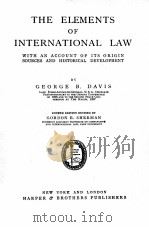
- THE ELEMENTS OF INTERNATIONAL LAW FOURTH EDITION
- 1916 HARPER AND BROTHERS PUBLISHERS
-
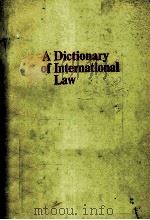
- A DICTIONARY OF INTERNATIONAL LAW
- 1982 PROGRESS PUBLISHERS
-
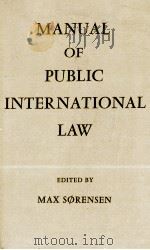
- MANUAL OF PUBLIC INTERNATIONAL LAW
- 1968 THE MACMILLAN PRESS LTD
-

- A BRITISH DIGEST OF INTERNATIONAL LAW VOLUME2B PARTII1
- 1967 STEVENS AND SONS
-

- Law of International Trade
- 1998 Sweet & Maxwell
-
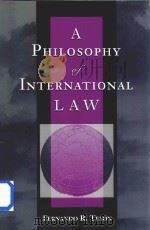
- A Philosophy of International Law
- 1998 Westview Press
-

- A MANUAL OF ROMAN PRIVATE LAW SECOND EDITION
- 1939 CAMBRIDGE AT THE UNIVERSITY PRESS
-
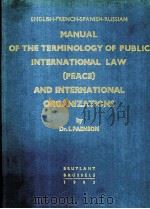
- MANUAL OF THE TERMINOLOGY OF PUBLIC INTERNATIONAL LAW (PEACE) AND INTERNATIONAL ORGANIZTIONS
- 1983 BRYLANT BRUSSELS
-
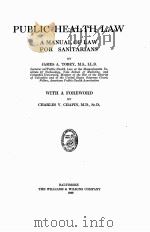
- PUBLIC HEALTH LAW A MANUAL OF LAW FOR SANITARIANS
- 1926 THE WILLIAMS AND WILKINS COMPANY
-
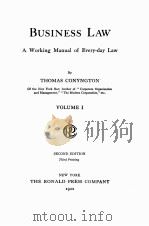
- BUSINESS LAW A WORKING MANUAL OF EVERY-DAY LAW SECOND EDITION VOLUME I
- 1922 THE RONALD PRESS COMPANY
-
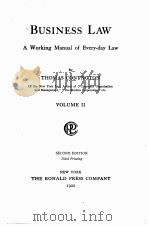
- BUSINESS LAW A WORKING MANUAL OF EVERY-DAY LAW SECOND EDITION VOLUME II
- 1922 THE RONALD PRESS COMPANY
-

- A MANUAL OF COMMON LAW TWELFTH EDITION
- 1905 STEVENS AND SONS
-

- A HANDBOOK OF PUBLIC INTERNATIONAL LAW TENTH EDITION
- 1927 MACMILLAN AND CO.
提示:百度云已更名为百度网盘(百度盘),天翼云盘、微盘下载地址……暂未提供。➥ PDF文字可复制化或转WORD

